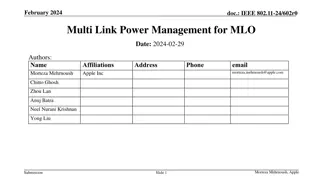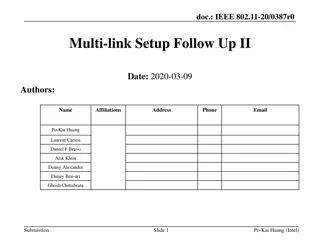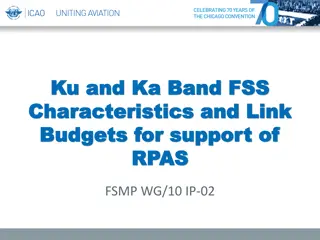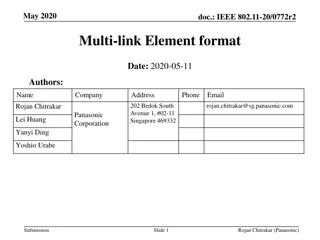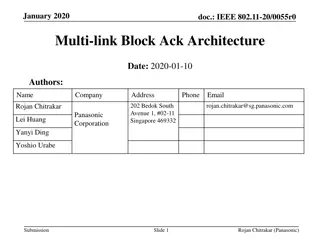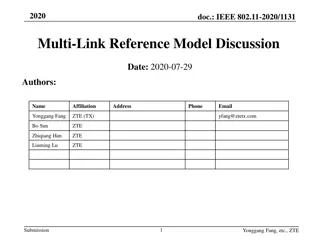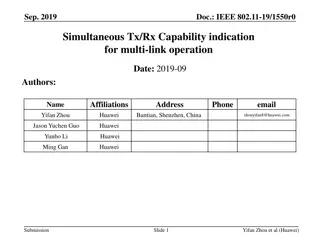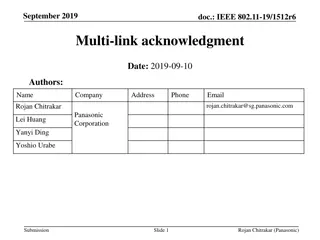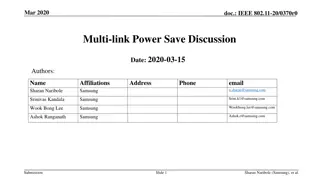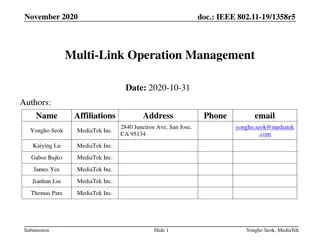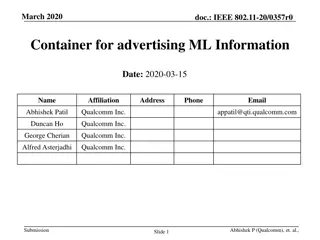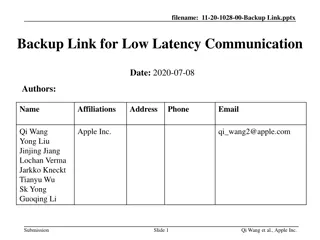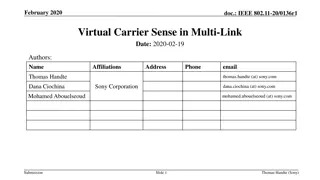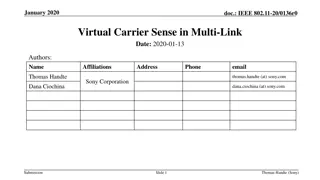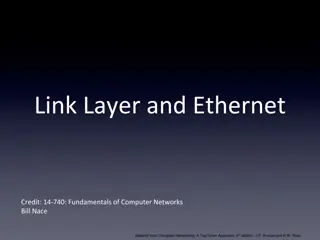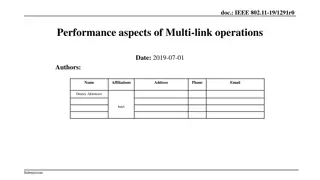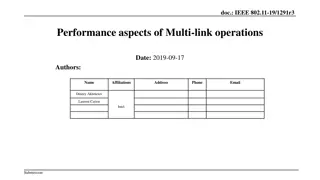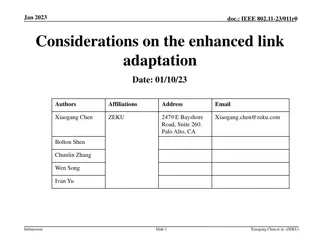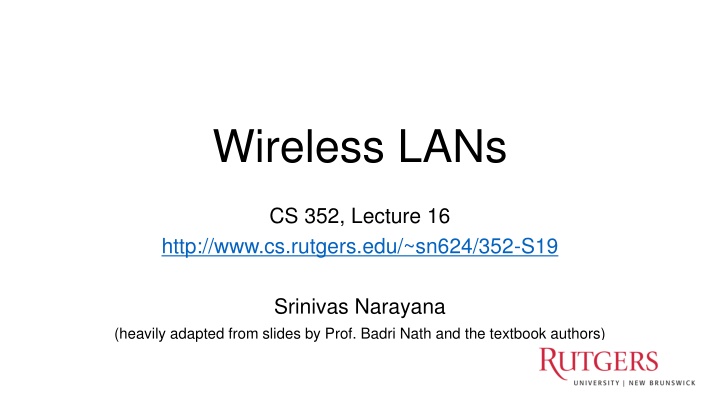
Elements of Wireless Networks in Mobile Communication
Explore the essential components of wireless networks in mobile communication, covering topics like network infrastructure, wireless hosts, base stations, and wireless links. Learn about the challenges of mobility, communication over wireless links, and the increasing prevalence of wireless devices over wired ones. Discover the taxonomy of wireless networks, including multiple hops and single hops, and gain insights into the characteristics and trends shaping the realm of wireless networking.
Download Presentation

Please find below an Image/Link to download the presentation.
The content on the website is provided AS IS for your information and personal use only. It may not be sold, licensed, or shared on other websites without obtaining consent from the author. If you encounter any issues during the download, it is possible that the publisher has removed the file from their server.
You are allowed to download the files provided on this website for personal or commercial use, subject to the condition that they are used lawfully. All files are the property of their respective owners.
The content on the website is provided AS IS for your information and personal use only. It may not be sold, licensed, or shared on other websites without obtaining consent from the author.
E N D
Presentation Transcript
Wireless LANs CS 352, Lecture 16 http://www.cs.rutgers.edu/~sn624/352-S19 Srinivas Narayana (heavily adapted from slides by Prof. Badri Nath and the textbook authors) 1
Wireless and Mobile Networks Background: # wireless (mobile) phone subscribers now exceeds # wired phone subscribers (5-to-1)! # wireless Internet-connected devices equals # wireline Internet-connected devices laptops, Internet-enabled phones promise anytime untethered Internet access two important (but different) challenges wireless: communication over wireless link mobility: handling the mobile user who changes point of attachment to network 2
Elements of a wireless network network infrastructure 3
Elements of a wireless network wireless hosts laptop, smartphone run applications may be stationary (non- mobile) or mobile wireless does not always mean mobility network infrastructure 4
Elements of a wireless network base station typically connected to wired network relay - responsible for sending packets between wired network and wireless host(s) in its area e.g., cell towers, 802.11 access points network infrastructure 5
Elements of a wireless network wireless link typically used to connect mobile(s) to base station also used as backbone link multiple access protocol coordinates link access various data rates, transmission distance network infrastructure 6
Wireless network taxonomy multiple hops single hop host may have to relay through several wireless nodes to connect to larger Internet: mesh net host connects to base station (WiFi, WiMAX, cellular) which connects to larger Internet infrastructure (e.g., APs) no base station, no connection to larger Internet. May have to relay to reach other a given wireless node MANET, VANET no base station, no connection to larger Internet (Bluetooth, ad hoc nets) no infrastructure 7
Wireless network characteristics
Wireless Link Characteristics (1) important differences from wired link . decreased signal strength: radio signal attenuates as it propagates through matter (path loss) interference from other sources: standardized wireless network frequencies (e.g., 2.4 GHz) shared by other devices (e.g., phone); devices (motors) interfere as well multipath propagation: radio signal reflects off objects ground, arriving ad destination at slightly different times . make communication across (even a point to point) wireless link much more challenging 9
Wireless Link Characteristics (2) SNR: signal-to-noise ratio larger SNR easier to extract signal from noise (a good thing ) 10-1 10-2 10-3 BER 10-4 SNR versus BER tradeoffs given physical layer: increase power -> increase SNR->decrease BER given SNR: choose physical layer that meets BER requirement, giving highest thruput 10-5 10-6 10-7 10 20 30 40 SNR(dB) QAM256 (8 Mbps) SNR may change with mobility: dynamically adapt physical layer (modulation technique, rate) QAM16 (4 Mbps) BPSK (1 Mbps) 10
Wireless network characteristics Multiple wireless senders and receivers create additional problems (beyond multiple access): B A C C C s signal strength A s signal strength B A space Hidden terminal problem B, A hear each other B, C hear each other A, C can not hear each other means A, C unaware of their interference at B Signal attenuation: B, A hear each other B, C hear each other A, C can not hear each other interfering at B 11
IEEE 802.11 Wireless LAN 802.11a 5-6 GHz range up to 54 Mbps 802.11g 2.4-5 GHz range up to 54 Mbps 802.11n: multiple antennae 2.4-5 GHz range up to 200 Mbps 802.11b 2.4-5 GHz unlicensed spectrum up to 11 Mbps all use CSMA/CA for multiple access all have base-station and ad-hoc network versions 12
802.11: Channels, association 802.11b: 2.4GHz-2.485GHz spectrum divided into 11 channels at different frequencies AP admin chooses frequency for AP interference possible: channel can be same as that chosen by neighboring AP! host: must associate with an AP scans channels, listening for beacon frames containing AP s name (SSID) and MAC address selects AP to associate with may perform authentication [Chapter 8] will typically run DHCP to get IP address in AP s subnet 13
WiFi (802.11) multiple access CSMA/CA
Review: MAC protocols: Taxonomy three broad classes: channel partitioning divide channel into smaller pieces (time slots, frequency, code) allocate piece to node for exclusive use random access channel not divided, allow collisions recover from collisions taking turns nodes take turns, but nodes with more to send can take more or longer turns 15
Review: Ethernet CSMA/CD algorithm 1. NIC receives datagram from network layer, creates frame 2. If NIC senses channel idle, starts frame transmission. If NIC senses channel busy, waits until channel idle, then transmits. 3. If NIC transmits entire frame without detecting another transmission, NIC is done with frame ! 4. If NIC detects another transmission while transmitting, aborts and sends jam signal 5. After aborting, NIC enters binary (exponential) backoff: after mth collision, NIC chooses K at random from {0,1,2, , 2m-1}. NIC waits K 512 bit times, returns to Step 2 longer backoff interval with more collisions 16
IEEE 802.11: multiple access avoid collisions: 2+ nodes transmitting at same time 802.11: CSMA - sense before transmitting don t collide with ongoing transmission by other node 802.11: no collision detection! difficult to receive (sense collisions) when transmitting due to weak received signals (fading) can t sense all collisions in any case: hidden terminal, fading goal: avoid collisions: CSMA/C(ollision)A(voidance) B A C C C s signal strength A s signal strength B A space 17
IEEE 802.11 MAC Protocol: CSMA/CA 802.11 sender 1 if sense channel idle for DIFS then transmit entire frame (no CD) 2 if sense channel busy then start random backoff time timer counts down while channel idle transmit when timer expires if no ACK, increase random backoff interval, repeat 2 802.11 receiver - if frame received OK return ACK after SIFS (ACK needed due to hidden terminal problem) sender receiver DIFS data SIFS ACK 18
Avoiding collisions (more) idea: allow sender to reserve channel rather than random access of data frames: avoid collisions of long data frames sender first transmits small request-to-send (RTS) packets to BS using CSMA RTSs may still collide with each other (but they re short) BS broadcasts clear-to-send CTS in response to RTS CTS heard by all nodes sender transmits data frame other stations defer transmissions avoid data frame collisions completely using small reservation packets! 19
Collision Avoidance: RTS-CTS exchange B A AP reservation collision DATA (A) defer time 20
Wireless multiple access Code Division Multiple Access (CDMA)
Code Division Multiple Access (CDMA) unique code assigned to each user; i.e., code set partitioning all users share same frequency, but each user has own chipping sequence (i.e., code) to encode data allows multiple users to coexist and transmit simultaneously with minimal interference (if codes are orthogonal ) encoded signal = (original data) X (chipping sequence) decoding: inner-product of encoded signal and chipping sequence 22
CDMA encode/decode channel output Zi,m Zi,m= di.cm data bits d0 = 1 1 1 1 1 1 1 1 1 d1 = -1 1 - 1 - 1 - 1 - 1 - 1 - 1 - 1 - sender slot 0 channel output slot 1 channel output 1 1 1 1 1 1 1 1 code 1 - 1 - 1 - 1 - 1 - 1 - 1 - 1 - slot 1 slot 0 M Di = SZi,m.cm m=1 M received input 1 1 1 1 1 1 1 1 d0 = 1 1 - 1 - 1 - 1 - 1 - 1 - 1 - 1 - d1 = -1 slot 0 channel output slot 1 channel output 1 1 1 1 1 1 1 1 code 1 - 1 - 1 - 1 - 1 - 1 - 1 - 1 - receiver slot 1 slot 0 23
CDMA: two-sender interference channel sums together transmissions by sender 1 and 2 Sender 1 Sender 2 using same code as sender 1, receiver recovers sender 1 s original data from summed channel data! 24
Summary of the wireless link layer Wireless medium is very different from wired Signal attenuation ( fading ) much more important to handle Hidden terminal problem Consequences of differences: Link-layer ACKs Transmission delays to control contention: SIFS, DIFS Link reservation (RTS/CTS) Medium access control Frequency division multiple access (AP channels in WiFi) Random access (CSMA/CA for transmitting to/from WiFi AP) Code division multiple access (simultaneous transmission in cellular networks) 25

